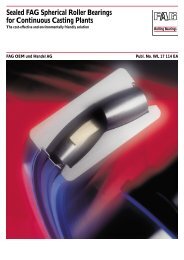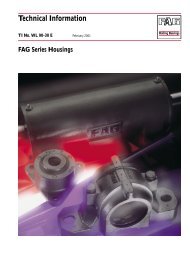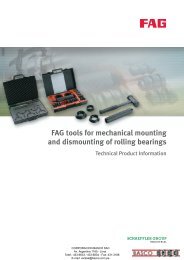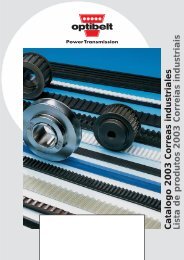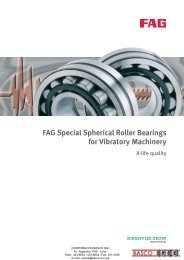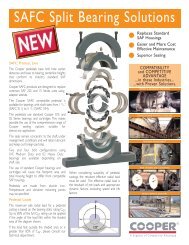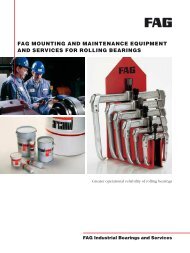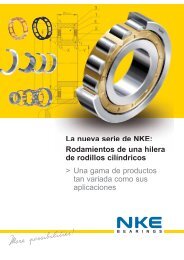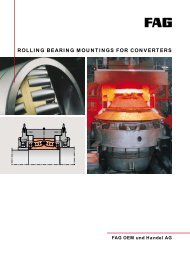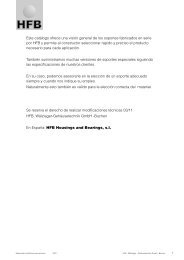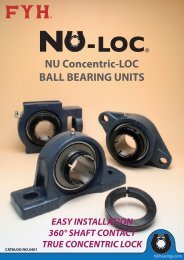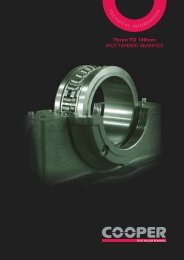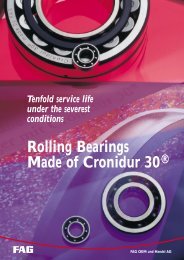You also want an ePaper? Increase the reach of your titles
YUMPU automatically turns print PDFs into web optimized ePapers that Google loves.
70 Calender thermo rolls<strong>The</strong> paper passes through the so-called calender stackafter leaving the dryer section. S<strong>of</strong>t calenders smooththe surface <strong>of</strong> the paper thus improving its printability.<strong>The</strong> calender consists <strong>of</strong> two pairs <strong>of</strong> rolls. One calenderroll (steel) lies above a counter roll, another belowone. <strong>The</strong> counter roll is the so-called anti-deflectionroll (elastic material). S<strong>of</strong>t calender rolls can be heatedby water, steam, or oil. <strong>The</strong> gap or the "nip" pressuredepends on the type <strong>of</strong> paper.Operating dataUseful width approx. 7 mRotation 350 min –1 (speed 1,100 m/min)Heated by oil at 200...250 °CInsulated roll journalOperating temperature at bearing inner ring 130 °C.Requirements with respect to load carrying capacityand self-alignment are met by spherical roller bearings.<strong>The</strong> cross section height <strong>of</strong> the bearing is limited bythe diameter <strong>of</strong> the roll journal and roll shell. <strong>The</strong>relatively wide spherical roller bearings FAG231/560AK.MB.C4.T52BW are mounted.<strong>The</strong> nominal life L h = 83,000 h with given loads andpercentages <strong>of</strong> time.With a lubricating oil ISO VG 220 the viscosity ratiois = 0.71 under an operating temperature <strong>of</strong> 130 °C.An attainable life L hna > 100,000 h is obtained with theadjusted rating life calculation (where f s* > 12; a 23II =1.2; V = 0.5; s = 1.6).<strong>The</strong> increased radial clearance C4 is required due tothe danger <strong>of</strong> detrimental radial preload in the bearingduring the heating up phase when the temperaturedifference is great. With a speed index n · d m =224,000 min –1 · mm we recommend bearings withincreased running accuracy according to specificationT52BW.<strong>Bearing</strong> selection, dimensioning<strong>The</strong> radial bearing load depends on the application <strong>of</strong>the calender roll as lower or upper roll, on the weightF G and the variable pressure load with percentage <strong>of</strong>time.P 1 = F G + F nip minP 2 = F G + F nip medP 3 = F G + F nip maxP 4 = F G – F nip minP 5 = F G – F nip medP 6 = F G – F nip max= 600 kN= 990 kN= 1,260 kN= 60 kN= 390 kN= 720 kNPercentages <strong>of</strong> time: P 1 , P 4 : 10 % eachP 2 , P 3 , P 5 , P 6 : 20 % each<strong>The</strong> sum <strong>of</strong> the roll weight and the nip load acts forthe application as bottom roll whereas their differenceacts for the application as top roll.Taking the maximum load for designing the bearingwould lead to overdimensioning (equivalent dynamicload P < 0.02 · dynamic load rating C) in the case <strong>of</strong>application in the top roll. Slippage may occur withsuch a low load which in turn can lead to bearing damagewhen lubrication is inadequate. In order to avoidthis problem, smaller bearings with a smaller dynamicload rating C should be selected so that P/C > 0.02.<strong>The</strong> risk <strong>of</strong> breaking through the lubricating filmdrops with the smaller roller mass.Machining tolerances<strong>The</strong> inner rings have circumferential load and are directlyfitted on the tapered roll journal. <strong>The</strong> roll journalshave oil ducts so that the hydraulic method can beapplied for mounting and dismounting the bearings.Roundness tolerance IT5/2 (DIN ISO 1101), taperangle tolerance AT7 (DIN 7178).<strong>Bearing</strong> seats in the housing boring according to F7.LubricationOil circulation lubrication with a synthetic oil ISO VG220, suitable in quality, which has stood dynamic testingon the FAG test rig FE8.By supplying a large amount <strong>of</strong> oil to the centre <strong>of</strong> thebearing (minimum flow rate 12 l/min) heat dissipationis achieved as well as a low thermal stress <strong>of</strong> the oil.Any contaminants or wear particles are washed out <strong>of</strong>the bearing. Oil returns at both sides <strong>of</strong> the bearing viaoil collecting pockets and connecting holes.SealingAngle rings at the roll side prevent direct oil escape atthe cover holes. Remaining oil is thrown <strong>of</strong>f by splashgrooves into collecting chambers and directed back.Cover seals make the housing oilpro<strong>of</strong>.FAG 98



